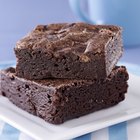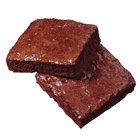
One of the reasons so many people love brownies is that there's no single canonical way to make them. Some like them thin and fudgy; others prefer them thick and cakelike. They can be glazed or iced, perfectly plain or loaded with chocolate chips and caramel pieces. They're even quick and easy, if you work with a prepared mix. Most mixes call for vegetable oil, but if you're out -- or if you just prefer a richer brownie -- you can use melted butter instead.
Butter vs. Oil
Vegetable oil is a vague term that includes oils from a number of sources, from soybeans and corn to sunflowers or canola. Although they vary in their nutritional value, most share a few common characteristics. They're usually neutral in flavor and low in saturated fats, and some are high in heart-healthy omega-3 and omega-6 fatty acids. Butter, in contrast, is high in saturated fats and is a less virtuous option. Yet it's popular as a baking ingredient because it adds an unmistakeably rich flavor.
Substitution
If you're planning to use melted butter in your brownie mix, you might need to make some small adjustments. For one thing, vegetable oil consists entirely of fat. Butter is a more complex combination of fats, proteins, sugars and water. Most brands are approximately 80 percent butterfat by weight, so a cup of butter isn't directly equivalent to a cup of oil. For example, if your preferred brand of mix calls for 1/2 of oil, you'd need to add an extra tablespoon of butter to provide the same amount of fat. Your mix will have slightly more moisture than usual, though it's unlikely to affect the texture once the brownies are baked.
Light Butters
If you regularly use a "light" brand of butter for table purposes, you'll need to work a little harder for your brownies. Some brands of light butter whip additional air into the butter, leaving its basic components unchanged but reducing the amount you'll use. Others incorporate extra water or milk, or substitute vegetable oil for part of the butterfat. If your butter is whipped, simply melting it eliminates the extra air and makes it the same as regular butter. If it contains extra liquids, melt the butter and use a ladle to separate the melted fat from the milky liquid at the bottom of your cup.
Margarine
If you want your brownies to have more flavor than vegetable oil can provide, but aren't comfortable with butter's saturated fats, you could compromise and use a good brand of margarine instead. It will give your brownies a butterlike flavor without the saturated fats. You'll probably find that brownies baked with margarine are slightly softer, and have a less-distinct crust. They may also require an extra one or two minutes' baking time to set properly.
Related Articles

Cake Mix Alternative for Oil

How to Substitute Margarine for Butter ...

Butter Substitute for Baking Scones

How to Use Shortening Instead of Oil ...

What Can Be Used to Substitute for ...
How to Substitute Sour Cream for Oil in ...

Substitution for Oil in Baking Brownies

Substitute for 1 Square of Baking ...

Calories in Dark Chocolate Truffles

Do You Measure Applesauce in Dry or ...

What Can I Substitute Unsalted Butter ...

What Happens if You Substitute Butter ...

Does Whipped Butter Have to Be ...

How to Replace Ingredients to Make ...

Can You Use Butter Instead of Cooking ...

Can I Put Butter in Brownie Mix Instead ...

Can You Make a Boxed Cake Without ...

Does Adding an Extra Egg to Brownie Mix ...

Can I Use Ripe Bananas Instead of Oil ...

Heavy Cream vs. Milk in Baking
References
Writer Bio
Fred Decker is a trained chef and certified food-safety trainer. Decker wrote for the Saint John, New Brunswick Telegraph-Journal, and has been published in Canada's Hospitality and Foodservice magazine. He's held positions selling computers, insurance and mutual funds, and was educated at Memorial University of Newfoundland and the Northern Alberta Institute of Technology.
Photo Credits
Stockbyte/Stockbyte/Getty Images